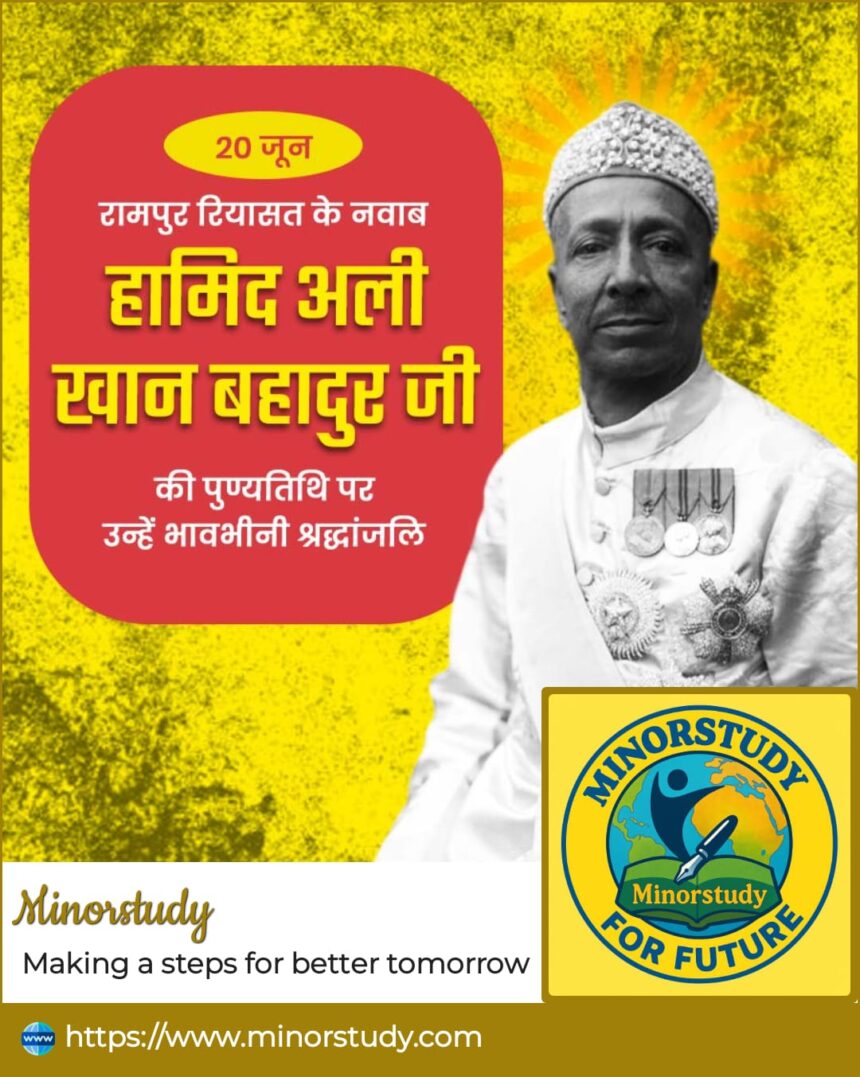Explore 5 powerful facts about Nawab Hamid Ali Khan Bahadur of Rampur – a visionary ruler who shaped culture, education, and modern governance in India’s princely era.
🌟 Introduction
Nawab Hamid Ali Khan Bahadur was not just a ruler; he was a visionary who shaped the princely state of Rampur with wisdom, reform, and cultural patronage. As the last fully sovereign Nawab of Rampur before India’s independence and integration, his rule spanned a period of transformation, progress, and political evolution.
In this article, we explore 5 surprising truths about Nawab Hamid Ali Khan Bahadur, diving deep into his life, legacy, and impact. From architectural wonders to educational reforms, and from literary patronage to political diplomacy, this is the untold story of a remarkable leader.
🕰️ Timeline of Nawab Hamid Ali Khan Bahadur’s Life
| Year | Event |
|---|---|
| 1875 | Born into the royal family of Rampur |
| 1889 | Succeeded his father Nawab Kalb Ali Khan at the age of 14 |
| 1891 | Full administrative powers granted after British regency |
| 1901-1911 | Significant modernization of Rampur state; launched welfare reforms |
| 1911 | Attended the Delhi Durbar to honor King George V |
| 1920s-1930s | Patronized arts, built key educational institutions |
| 1930 | Appointed a Knight Grand Commander of the Order of the Star of India |
| 1930-1936 | Continued modernization, began retiring from active administration |
| 1936 | Died and succeeded by his son Raza Ali Khan Bahadur |
📜 History of Nawab Hamid Ali Khan Bahadur
Born in 1875, Nawab Hamid Ali Khan Bahadur was a scion of the Nawabs of Rampur, a princely state in present-day Uttar Pradesh, India. He was the son of Nawab Kalb Ali Khan, an erudite ruler himself. Hamid Ali ascended the throne at a young age and was educated under British supervision, which deeply influenced his approach to governance.
Under British indirect rule, he quickly emerged as a capable administrator and was granted full powers in 1891. He focused on infrastructure, education, judiciary, and cultural development. His tenure is often referred to as the “Golden Era of Rampur” because of his progressive vision.
He maintained a diplomatic balance between British loyalty and local interests, ensuring peace and prosperity in the region.
🧠 Fascinating Facts About Nawab Hamid Ali Khan Bahadur
-
Youngest Nawab to Rule: Took power at just 14, and led the state with maturity beyond his years.
-
Art and Music Patron: Revived Rampur’s musical gharana and supported Urdu and Persian literature.
-
Architectural Legacy: Built iconic structures like the Hamid Manzil and expanded the Rampur Raza Library.
-
Women’s Welfare Pioneer: Introduced progressive reforms, including education for women.
-
Diplomatic Genius: Maintained strong relations with the British while defending his people’s interests.
🔍 Significance of His Rule
Nawab Hamid Ali Khan’s reign is significant for many reasons:
✅ Modernization of Rampur
He introduced a western-style judicial system, improved administrative transparency, and encouraged public works. Under his rule, roads, schools, and hospitals flourished.
✅ Literary and Cultural Renaissance
A patron of the arts, he attracted poets, musicians, and scholars. The Rampur Raza Library—which houses rare manuscripts and books—owes much of its expansion to him.
✅ Political Influence
He played a diplomatic role in maintaining peace between princely states and the British Crown. His presence in imperial events such as the Delhi Durbar reflects his political importance.
✅ Cultural Syncretism
Hamid Ali Khan preserved Rampur as a hub of Indo-Islamic culture, blending Mughal elegance with Awadhi grace, visible in language, cuisine, music, and dress.
🙏 Heartfelt Wishing on His Remembrance
On the remembrance of Nawab Hamid Ali Khan Bahadur, we extend our deepest respects:
“May the legacy of Nawab Hamid Ali Khan continue to inspire generations with values of wisdom, culture, and social justice. His spirit lives in every page of a preserved manuscript and every brick of Rampur’s palaces.”
Whether you’re a student of history, a lover of architecture, or simply an admirer of visionary leadership, the Nawab’s legacy remains a shining beacon.
❓ Frequently Asked Questions (FAQs)
1. Who was Nawab Hamid Ali Khan Bahadur?
He was the Nawab of Rampur State from 1889 to 1936, known for his progressive reforms and cultural patronage.
2. What was Nawab Hamid Ali Khan famous for?
He was renowned for building schools, hospitals, libraries, and for reviving arts and music in Rampur.
3. Did Nawab Hamid Ali Khan have political influence beyond Rampur?
Yes, he had a notable presence in British India’s political affairs and participated in imperial events.
4. Is Rampur Raza Library related to him?
Yes, he significantly expanded it, and it’s now one of India’s most important manuscript libraries.
5. What reforms did he bring for women?
He promoted female education and supported social welfare programs for women, a rare move in princely India.
🎯 Key Points at a Glance
-
Reign Period: 1889–1936
-
Cultural Contribution: Revived Urdu-Persian literary traditions
-
Architectural Legacy: Hamid Manzil, extensions of Jama Masjid and the Raza Library
-
British Honours: Knight Grand Commander of the Star of India (GCSI)
-
Public Welfare: Built schools, water systems, and hospitals
-
Modernizer: Introduced reforms in judicial, educational, and public sectors
❤️ Importance in Our Life and Society
🔸 Cultural Preservation
Rampur remains a cultural jewel of India thanks to Nawab Hamid Ali Khan’s foresight. His legacy safeguards traditions that might otherwise have vanished.
🔸 Leadership Model
His balance of tradition with modern governance provides a model for inclusive leadership. Modern administrators and policymakers can draw inspiration from his thoughtful integration of reforms.
🔸 Educational Heritage
Educational institutions and libraries in Rampur still bear the imprint of his policies. Knowledge seekers from around the world visit Rampur to access rare resources.
🔸 Humanitarian Values
His concern for the welfare of women, poor citizens, and artistic communities set benchmarks for empathetic and visionary governance.
🧭 Observance and Modern Legacy
📅 Annually Remembered
Cultural events and seminars are occasionally held in Rampur and UP to honor his contributions, especially by literary societies and academic groups.
🏛️ Museums & Heritage Walks
The palaces and archives of Rampur attract history lovers, tourists, and scholars, keeping Nawab Hamid Ali Khan’s memory alive.
📚 Research and Scholarship
His reign is a subject of study in Indian princely history, cultural anthropology, and Indo-Islamic architecture.
🧩 Conclusion: Why Nawab Hamid Ali Khan Still Matters Today
Nawab Hamid Ali Khan Bahadur of Rampur wasn’t just a ruler — he was an architect of a progressive princely India. His foresight, cultural richness, and humane governance continue to resonate in today’s world where leaders are judged by empathy, inclusivity, and vision.
In a time when we seek role models rooted in heritage yet embracing modernity, Hamid Ali Khan’s life story becomes more relevant than ever.
✨ His vision built libraries, his heart healed communities, and his legacy still educates minds.
Let us remember him not as a bygone Nawab, but as a timeless mentor of governance, grace, and growth.









